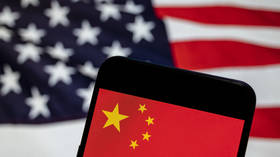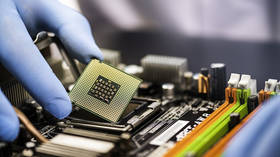The US carried out a ruthless campaign against Huawei, but its sanctions have simply made the firm find innovative ways to break the technology stranglehold placed on it.

There has been no other technology firm that has symbolized and encapsulated the dynamics of the emerging struggle between China and the United States the way Huawei has. The Shenzhen telecommunications firm has been one of China’s leading technology giants, and was subjected in 2019-2020 to a relentless campaign by the United States, which sought to destroy it through a variety of means.
From blocking exports to it, isolating it from global chipmakers, forcing allies to ban its participation in their 5G networks, imposing criminal charges against it and kidnapping one of its senior executives, America's campaign against the firm was relentless across the board and bruising to its commercial fortunes.
In 2021, Huawei’s sales ultimately tumbled because it was forced to sell off its popular smartphone brand, Honor, whilst also losing chip capacity, which severely limited its other high-end smartphone business. The firm’s network carrier business survived, and continues to lead the world in 5G market share outside of the handful of US-aligned countries who banned it, but Huawei founder and CEO Ren Zhengfei described the situation as a fight for the company’s survival.
Huawei is now bouncing back with renewed vigor. It is not only planning big, but acting big too. The company has not accepted its fate or the vice the US has placed around it to cut it off from global chip supplies. A story recently appeared in a series of Chinese news outlets stating that Huawei had established a new subsidiary, called Huawei Precision Manufacturing, armed with capital of 600 million yuan.
The new organization denied it would be making chips, but it has been tipped to focus on “the packaging, testing and assembling of high-end devices, modules, components in the fields of optoelectronics, wireless, digital energy, smart cars, and other terminal products” – many technologies which are associated with the chip industry.
But that isn't all: throughout the course of 2021, Huawei has quietly attained operating stakes in several Chinese semiconductor and lithography companies, essential root technologies which the US has sought to blacklist the firm from. There are also persistent reports that the company will open its own “wafer foundry” in Wuhan in 2022. While its new subsidiary might not be making chips, it is evident that Huawei as a whole is striving to do so. It is creating an entire self-owned supply chain for itself, outside of America’s clutches.
While this will not be an easy or short-term task, these developments are big red flags that America's technology war against China may be about to backfire, and that its campaign to isolate and damage Huawei has passed its peak.
Washington’s primary weapon against Chinese companies has been its commerce department’s “entity list” – a prohibition which seeks to block the export of sensitive or critical technologies to the designated target. Both the Biden and Trump administrations have been obsessed with it, adding an ever-growing list of Chinese technology companies across all critical sectors, such as telecommunications, artificial intelligence, aerospace, biotechnology and semiconductor firms.
The US believes it can contain China's rise in critical technologies by blocking supplies of high-end technology, crippling the capabilities of the businesses.
While these firms could source supplies from outside of the US, Washington brought in an additional sanction, for Huawei in particular, entitled “The Foreign Direct Product Rule,” banning companies who use any American semiconductor patents from supplying Huawei. Hence the firm’s particularly difficult situation.
Washington has assumed that China will struggle to innovate the respective technology needed itself. But because the United States made the challenge against Huawei political, the company, and China as a whole, has a point to prove by ensuring its success.The firm has subsequently poured billions into not only redeveloping and expanding the scope of its business, but also towards making itself self-reliant.
Huawei should not be underestimated, as it has one of the highest research and development budgets on the planet, the fifth-highest worldwide as a company, which last year alone exceeded $20 billion. In fact, this R&D budget alone as a company exceeds that of entire countries, such as Australia. How does Huawei afford it? The company isn't truly on its knees, but receives a large income through its dominance of 5G patents that earn billions in royalties.
Instead of killing the company, US sanctions against it have simply made it fire all guns blazing towards breaking the technology stranglehold placed on it. For the time being, the exact capabilities that Huawei’s manufacturing will soon have are unclear. It is widely understood that China is not able to make certain types of chips on its own accord, due to having no access to the extreme ultraviolet lithography technology the US is also depriving it of.
However, it was quietly announced that Huawei would launch its own chipset by 2022, and declared that it would “regain their smartphone crown” by 2023. How is it going to do this? The company clearly has something up its sleeve which we don’t know about, leaving the whole process hidden in secrecy.
But one thing is clear: against all the odds, Huawei has set itself on the path towards breaking out of the US tech embargo placed on it. Americans have repeatedly said China can’t innovate, have persistently accused them of “stealing technology” and staked all on blocking China’s technological rise.
But what happens if a single company not only finds a way to outdo this, but likewise provides means to other blacklisted firms as well? Huawei appears to be not only preparing to create new chips in the long run, but potentially semiconductor-related equipment too.
It serves as a reminder that it is indeed a company of strategic importance in China, and that might just be why the US has gone after it so aggressively. As such an innovative firm, Huawei won’t play by the constraints the US has set for it, but is ultimately looking towards changing the game by inventing something new and forcing its way out. In trying to kill the ‘monster’, America has created a bigger, stronger one; Washington’s politicians may not have realized their mistake yet, but when they do, it will hit them hard.
The statements, views and opinions expressed in this column are solely those of the author and do not necessarily represent those of RT.



0 Comments:
Post a Comment
Subscribe to Post Comments [Atom]
<< Home